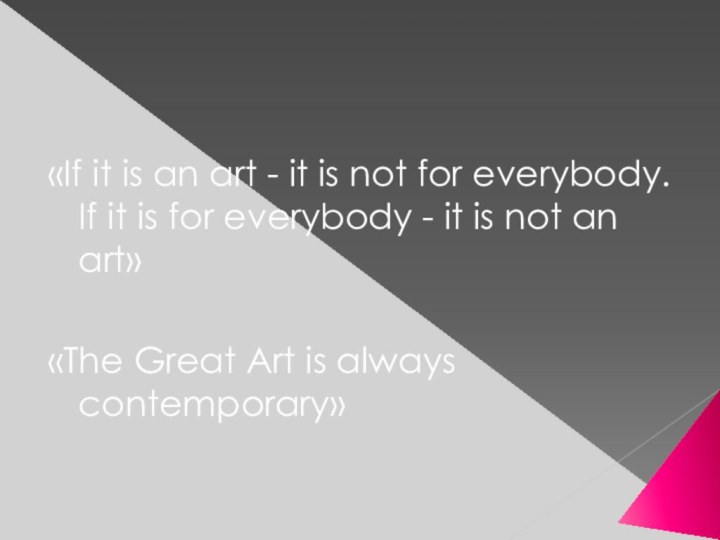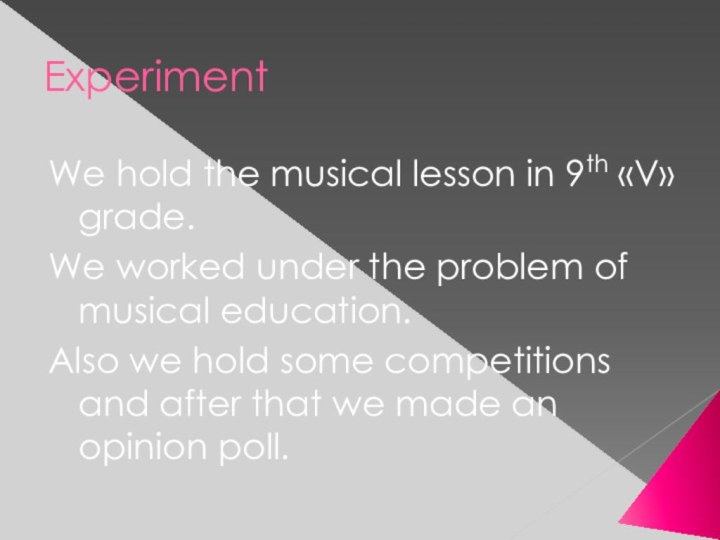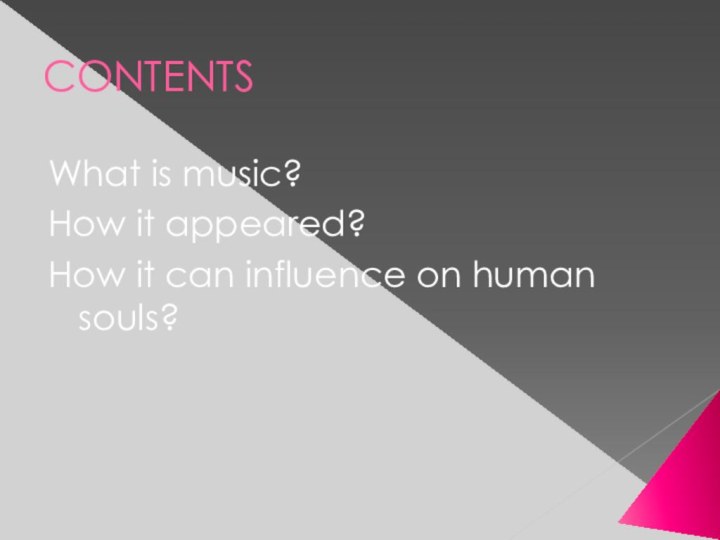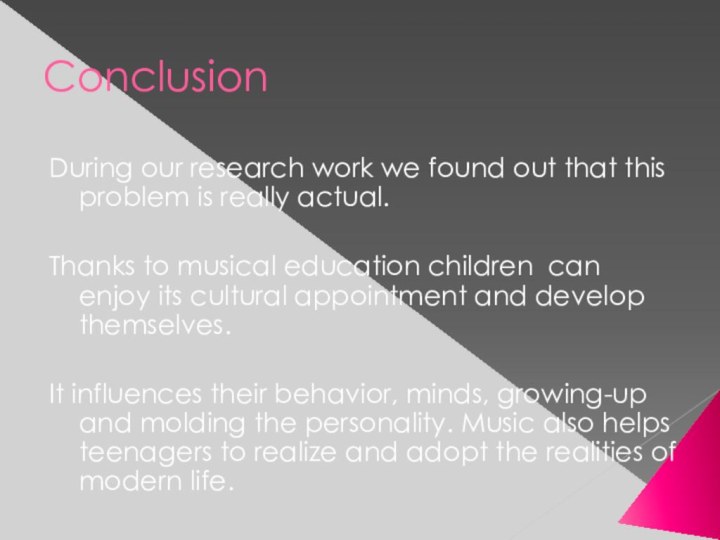Слайд 2
People say...
«Music create feelings which you have
not got in usual life»
Stanislav Vitkevich
«What Berlioz said by
his music? –Nothing, but how wonderful he said!»
James Hewener
«Life without music would be a mistake»
Nitce
Слайд 3
The structure of the researching:
Urgency of the research
Problem
Object
of the research
Subject of the research
Aim
Objectives
Hypothesis
Methods
Слайд 4
Urgency of the research
Music is the social need.
It is necessary for development and enrichment.
Слайд 5
Problem
Many people listen to music, but not everybody
can understand it. Its influence and role in people‘s
life.
Слайд 6
Object and subject of the researching
Music and children.
Music
education on the children of gymnasia №1.
Слайд 7
Aim
To appeal teenagers attention to the problem of
musical influence on people’s minds.
Слайд 8
Objectives
To study literature on the problem
To make an
opinion poll
To hold a lesson, dedicated to music
To make
booklets on our theme and to distribute them
Слайд 9
Hypothesis
We are sure that music influences people’s minds
a lot, their activity and molding a personality.
Слайд 10
Methods
Theotretical method:
analysis of literature on the theme
looking for
visual support
Empirical method:
to make an opinion poll
to hold a
musical lesson
Слайд 11
Product
Children’s pictures, booklets
Слайд 12
Introduction
Music as a kind of art gives a
person an ability to know the world and to
develop himself.
Finding new information, knowledge and skills children study musical art.
The influence of music on children’s cultural education – is very complicated, important and actual question.
Слайд 13
Nowadays we live in such world where you
can listen to music nearly everywhere.
Слайд 14
PAGES OF HISTORY
Many scientists have been working on
this problem. It is a fact that even our
ancestors thought over the appearance and influence of music.
Many ancient philosophers spoke about the importance and great influence of music, such as:
Pifagor, Platon, Aristotel, Democrit
Слайд 15
«...the life moves, changes itself, so music also
do not stay at all, it develops..»
Слайд 16
Why adults who want to make children love
classic music even do not visit such concerts by
themselves?
Слайд 17
«If it is an art - it is
not for everybody. If it is for everybody -
it is not an art»
«The Great Art is always contemporary»
Слайд 18
Experiment
We hold the musical lesson in 9th «V»
grade.
We worked under the problem of musical education.
Also we
hold some competitions and after that we made an opinion poll.
Слайд 20
How often parents talk with you about the
music?
Слайд 22
Must the music lessons be included into the
school program?
Слайд 23
CONTENTS
What is music?
How it appeared?
How it can influence
on human souls?
Слайд 24
Music. What is it?
Music is an art form
whose medium is sound.
Music can be divided into
genres and subgenres.
"There is no noise, only sound."
Слайд 25
Variety of music styles
Techno
House music
Detroit House
Deep House
Trance
Breakbeat
Tribal
Hardcore
Acid House
Ambient
Rock
music
Rap music
Hip - hop
Jazz
Stride
Boogie Woogie
Слайд 26
Techno
A fast and highly expressive style, which contained
a beautiful rhythmic basis and strongly reminiscent of techno-dance
Слайд 27
Rock
Cultural origins - 1950s and 1960s, United Kingdom,
United States
Typical instruments - vocals, electric guitar, bass guitar,
drums, synthesizer, keyboards
Mainstream popularity - worldwide, 1950s-2010s
Слайд 28
Pop
Cultural origins - 1950s, United States and United
Kingdom
Typical instruments - Vocals • Electric guitar • Bass
guitar • Drums • Keyboards• Acoustic Guitar • Synthesizer • Drum machine • Sequencer • Sampler
Mainstream popularity - continuous worldwide since emergence
Слайд 29
Classic
Cultural origins – The term "classical music" appeared
in the 16th century
Typical instruments - Violin •
Piano • Violoncello • Harp • Flute
Mainstream popularity – is popular in narrow circles
Слайд 30
Alternative
Cultural origins – 1980s, The United States of
America
Typical instruments - Electric guitar • Bass guitar •
Drums • Keyboards• Acoustic Guitar • Synthesizer • Drum machine • Sequencer • Sampler
Mainstream popularity - continuous worldwide since emergence
Слайд 31
Indie-rock
Cultural origins – 1980s, United States and United
Kingdom
Typical instruments - Vocals • Electric guitar • Bass
guitar • Drums • Acoustic Guitar • Drum machine • Sequencer • Sampler
Mainstream popularity – widely spread all over the world































